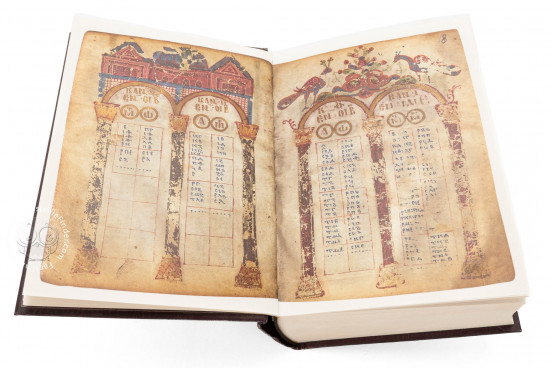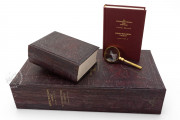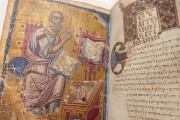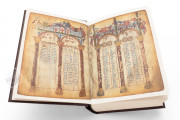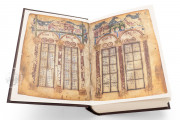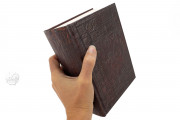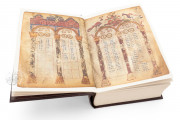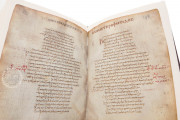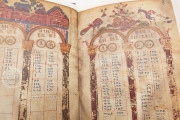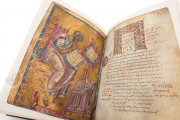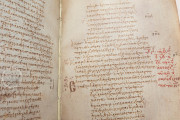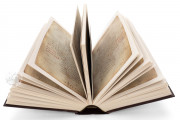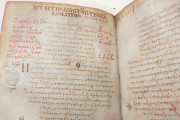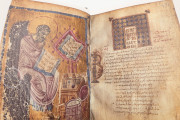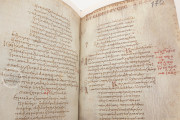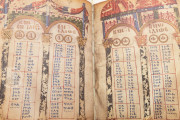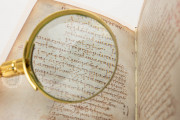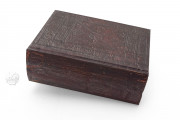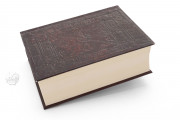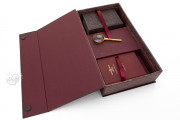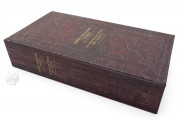The Korça Gospels is a remarkable monument of Byzantine manuscript painting unknown to scholars before the twentieth century. Its principal text—written in text fields in the shape of a cross—is the accounts of the life of Christ from the Christian Bible. That text was written in Constantinople in the first half of the tenth century. Additional text and full-page portraits of the four Gospel authors with gold backgrounds were added in the late thirteenth century, also in Constantinople. The original embellishment, dating from the tenth century, comprises twelve pages with painted architectural surrounds and ten headpieces.
The manuscript opens with a series of canon tables—tables of numbers indicating the concordance of passages among the Gospels (incomplete). The Gospels form the bulk of the text. Then follows the text added in the thirteenth century, which indicates the assignment of passages from the Gospels to be intoned in the liturgy.
Peacocks, Chandeliers, and Curtains
The canon tables occupy twelve pages (fols. 4-9), each with painted architecture of three columns spanned by gold arches. Each arcade is topped with embellishments that take the form of an angel (fol. 6v) peacocks (fol. 8r), other birds, chandeliers (fols. 4r and 5v), curtains, and stylized flowers. The headings are in gold, and the numbers are written in purple.
Four Evangelists, One Story
The portraits of the evangelists are remarkably similar in composition (fols. 12v, 92v, 141v, and 225v). Each author is pictured at the left in three-quarter view, seated on a large throne before a podium. He holds a book, and another book is perched on the podium. Below the podium is a table with writing implements. This similarity among the portraits emphasizes that, while the Christian Gospels are four, they are understood to tell one story.
Divinely Inspired Authors
Although the furniture associated with the human task of writing establishes the earthly setting for the evangelists' activity, the shimmering gold backgrounds emphasize the divine inspiration for their words. This is further emphasized in the portrait of Saint John: the Hand of God emerges from the arc of heaven to bless the saint and his activity (fol. 225v).
Bouletée, a Luxury Script
The Gospel text was written by a single scribe in Bouletée, a Greek minuscule script named for its "boules" (balls) and reserved for copying Christian scripture and the writings of the Church Fathers. The Korça Gospels is an important early example of an extended text written in text fields shaped like a cross. The insistence of this shaped writing helps to tie the four Gospel texts together. The titles and chapter headings are written in gold and red.
From Scripture to Lectionary
Two scribes wrote the schedule of liturgical assignments for Gospel readings, which was later incorporated into the manuscript (fols. 282-309). The addition of this section of text effectively transformed the scriptural codex into a liturgical book. Whether the evangelist portraits were inserted when this text was added (and whether they replaced earlier ones) is unknown.
Into the Archives
Most of the history of the Korça Gospels is unrecoverable. According to a note in the manuscript, the Gospel book was purchased by Loukas Skenoures from an unidentified monastery of "Perivleptos" in 1182; the book's conversion into a lectionary postdates this change in ownership. We next know that Dhimitër Moskopoliti, who presumably acquired the amplified book in Korça, sold it in 1985 to the Albanian Central State Archives. The manuscript is preserved in a sixteenth- or seventeenth-century Byzantine-style binding of blind-stamped brown leather over wooden boards.
We have 1 facsimile edition of the manuscript "Korça Gospels": Katërungjillëshi i Dekoruar i Korçës : (Kodiku i Korçës Nr. 93) facsimile edition, published by Militos, 2012
Request Info / Price
